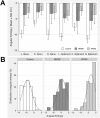Fourier transform power spectrum is a potential measure of tissue alignment in standard MRI: A multiple sclerosis study
- PMID: 28414816
- PMCID: PMC5393867
- DOI: 10.1371/journal.pone.0175979
Fourier transform power spectrum is a potential measure of tissue alignment in standard MRI: A multiple sclerosis study
Abstract
Loss of tissue coherency in brain white matter is found in many neurological diseases such as multiple sclerosis (MS). While several approaches have been proposed to evaluate white matter coherency including fractional anisotropy and fiber tracking in diffusion-weighted imaging, few are available for standard magnetic resonance imaging (MRI). Here we present an image post-processing method for this purpose based on Fourier transform (FT) power spectrum. T2-weighted images were collected from 19 patients (10 relapsing-remitting and 9 secondary progressive MS) and 19 age- and gender-matched controls. Image processing steps included: computation, normalization, and thresholding of FT power spectrum; determination of tissue alignment profile and dominant alignment direction; and calculation of alignment complexity using a new measure named angular entropy. To test the validity of this method, we used a highly organized brain white matter structure, corpus callosum. Six regions of interest were examined from the left, central and right aspects of both genu and splenium. We found that the dominant orientation of each ROI derived from our method was significantly correlated with the predicted directions based on anatomy. There was greater angular entropy in patients than controls, and a trend to be greater in secondary progressive MS patients. These findings suggest that it is possible to detect tissue alignment and anisotropy using traditional MRI, which are routinely acquired in clinical practice. Analysis of FT power spectrum may become a new approach for advancing the evaluation and management of patients with MS and similar disorders. Further confirmation is warranted.
Conflict of interest statement
Figures





Similar articles
-
Correlating new directional measures of myelin and axonal integrity in T2-weighted MRI with quantitative histology in multiple sclerosis.J Neurosci Methods. 2019 Jan 1;311:369-376. doi: 10.1016/j.jneumeth.2018.09.020. Epub 2018 Sep 19. J Neurosci Methods. 2019. PMID: 30240805
-
Diffusion tensor fractional anisotropy of the normal-appearing seven segments of the corpus callosum in healthy adults and relapsing-remitting multiple sclerosis patients.J Magn Reson Imaging. 2005 Jun;21(6):735-43. doi: 10.1002/jmri.20296. J Magn Reson Imaging. 2005. PMID: 15906348
-
Cervical cord area is associated with infratentorial grey and white matter volume predominantly in relapsing-remitting multiple sclerosis: A study using semi-automated cord volumetry and voxel-based morphometry.Mult Scler Relat Disord. 2015 May;4(3):264-72. doi: 10.1016/j.msard.2015.04.003. Epub 2015 Apr 15. Mult Scler Relat Disord. 2015. PMID: 26008944
-
Diffusion-weighted MR of the brain: methodology and clinical application.Radiol Med. 2005 Mar;109(3):155-97. Radiol Med. 2005. PMID: 15775887 Review. English, Italian.
-
Relapsing and progressive forms of multiple sclerosis: insights from pathology.Curr Opin Neurol. 2014 Jun;27(3):271-8. doi: 10.1097/WCO.0000000000000094. Curr Opin Neurol. 2014. PMID: 24722325 Free PMC article. Review.
Cited by
-
Regional Topological Aberrances of White Matter- and Gray Matter-Based Functional Networks for Attention Processing May Foster Traumatic Brain Injury-Related Attention Deficits in Adults.Brain Sci. 2021 Dec 24;12(1):16. doi: 10.3390/brainsci12010016. Brain Sci. 2021. PMID: 35053760 Free PMC article.
References
-
- Compston A, Coles A. Multiple sclerosis. Lancet. 2008;372: 1502–1517. doi: 10.1016/S0140-6736(08)61620-7 - DOI - PubMed
-
- Sastre-Garriga J, Ingle GT, Chard DT, Ramió-Torrentà L, McLean M a, Miller DH, et al. Metabolite changes in normal-appearing gray and white matter are linked with disability in early primary progressive multiple sclerosis. Arch Neurol. 2005;62: 569–73. doi: 10.1001/archneur.62.4.569 - DOI - PubMed
-
- Concha L. A macroscopic view of microstructure: Using diffusion-weighted images to infer damage, repair, and plasticity of white matter. Neuroscience. IBRO; 2014;276: 14–28. doi: 10.1016/j.neuroscience.2013.09.004 - DOI - PubMed
-
- Mori S, Zhang J. Principles of Diffusion Tensor Imaging and Its Applications to Basic Neuroscience Research. Neuron. 2006;51: 527–539. doi: 10.1016/j.neuron.2006.08.012 - DOI - PubMed
MeSH terms
LinkOut - more resources
Full Text Sources
Other Literature Sources

